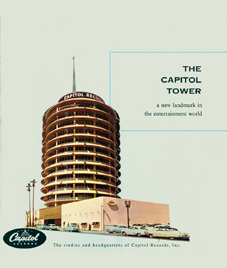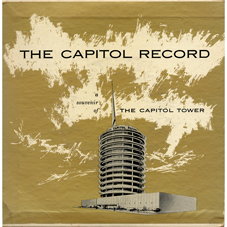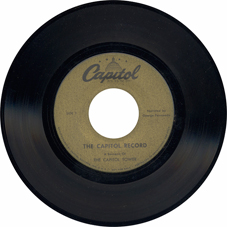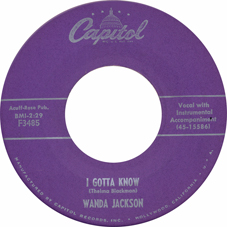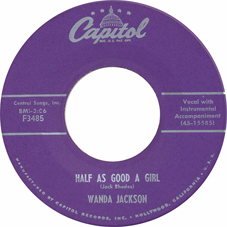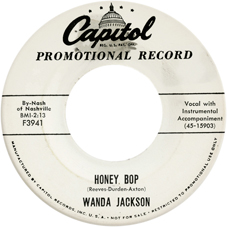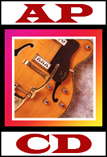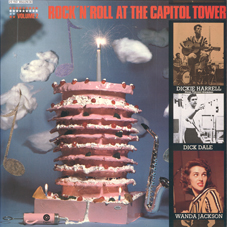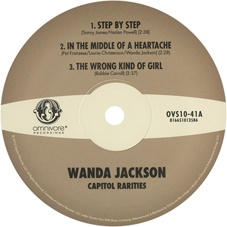No matter how much we may like Brenda Lee, Janis Martin and Jackie De Shannon,
the greatest female rockabilly/rock'n'roll singer is Wanda Jackson. Period. She's also a superlative country and Gospel artist. She began recording for Decca in 1954 but the big break occured when she signed with Capitol in 1956. Backed up over the years by such luminaries as Chet Atkins, Jerry Byrd and Bob White at Decca, then Joe Maphis, Ralph Mooney, Skeets Mc Donald, Buck Owens, Big Al Downing and later Roy Clark at Capitol, she could do no wrong. And she was equally electrifying on stage. The good news is, the party's still goin' on !
Time to join in & have a ball.
You can now enjoy the complete run of pics taken during one of the earliest Wanda Jackson recording sessions held at the famous Capitol Tower, located at 1750 North Vine Street in Hollywood ; these photos were taken either on June 8, 1956 (the 'I Gotta Know' session) or on September 20, 1956 ('Baby Loves Him' - I would favor that second date). Wanda seems totally at ease in the studio. One can clearly catch sight of both Joe Maphis and Buck Owens on guitars ; also visible is drummer Pee Wee Adams. All those precious photos were initially - and only - published in the January 1957 issue of US music mag, 'Country & Western Jamboree'.
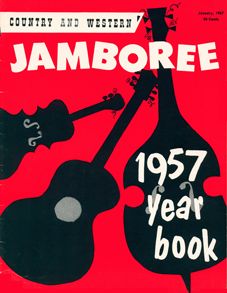 There was a small article and a biography which teach us that the mighty sweet Wanda Jackson was born on October 20, 1937, in Maud, Oklahoma. By the time she was 15, she had a radio spot on KLPR in Oklahoma City. There, disc jockey Jay Davis encouraged her and 'spent hours with her to help remove the 'green' from her early performances'.
A contract with Decca Records ensued and, at 16, she recorded her first songs, the very first being one of her compositions, 'If You Knew What I know', a real country weeper which featured a double-tracked vocal. From that same March 24, 1954, session, 'You Can't Have My Love' (#29140), complete with a recitation from Billy Gray, became her first ever single and achieved some success. Billy Gray again duetted with her on 'If You Don't, Somebody Else Will' (#29267) at a later session. Gray was a Decca artist himself ; he cut several singles between '54 and '56, including an excellent version of Marty Robbins' 'Tennessee Toddy' (#29800), and used to work as bandleader with Hank Thompson. Hank, whom Wanda had met while doing radio work, invited her to tour with him. She later became a fixture on the Ozark Jubilee in Springfield, Missouri. Her contract with Decca expired in late 1955 ; a total of fifteen songs had been recorded, which would be spread over seven 45's plus an LP which appeared as late as 1962 (after Wanda had scored a big country hit with 'Right Or Wrong') and didn't even contain 'You Can't Have My Love'. Those Decca tracks - predominantly hillbilly ballads, always moralistic - were good, some being written or co-written by Wanda herself. Most notable were her version of The Frontiersmen's 'Lovin' Country Style', 'I'd Rather Have a Broken Heart' (which saw the light on the LP), 'You Won't Forget (About Me)' and 'Wasted'.
There was a partial reissue of the Decca LP on their own budget Vocalion imprint in 1968 (oddly titled 'Nobody's Darlin', VL 73861) but it is in terrible simulated stereo and sports an atrocious painting on the cover. Happily, all fifteen songs were neatly reissued by Bear Family in 1983 ('Early Wanda Jackson' - BFX 15109).
There was a small article and a biography which teach us that the mighty sweet Wanda Jackson was born on October 20, 1937, in Maud, Oklahoma. By the time she was 15, she had a radio spot on KLPR in Oklahoma City. There, disc jockey Jay Davis encouraged her and 'spent hours with her to help remove the 'green' from her early performances'.
A contract with Decca Records ensued and, at 16, she recorded her first songs, the very first being one of her compositions, 'If You Knew What I know', a real country weeper which featured a double-tracked vocal. From that same March 24, 1954, session, 'You Can't Have My Love' (#29140), complete with a recitation from Billy Gray, became her first ever single and achieved some success. Billy Gray again duetted with her on 'If You Don't, Somebody Else Will' (#29267) at a later session. Gray was a Decca artist himself ; he cut several singles between '54 and '56, including an excellent version of Marty Robbins' 'Tennessee Toddy' (#29800), and used to work as bandleader with Hank Thompson. Hank, whom Wanda had met while doing radio work, invited her to tour with him. She later became a fixture on the Ozark Jubilee in Springfield, Missouri. Her contract with Decca expired in late 1955 ; a total of fifteen songs had been recorded, which would be spread over seven 45's plus an LP which appeared as late as 1962 (after Wanda had scored a big country hit with 'Right Or Wrong') and didn't even contain 'You Can't Have My Love'. Those Decca tracks - predominantly hillbilly ballads, always moralistic - were good, some being written or co-written by Wanda herself. Most notable were her version of The Frontiersmen's 'Lovin' Country Style', 'I'd Rather Have a Broken Heart' (which saw the light on the LP), 'You Won't Forget (About Me)' and 'Wasted'.
There was a partial reissue of the Decca LP on their own budget Vocalion imprint in 1968 (oddly titled 'Nobody's Darlin', VL 73861) but it is in terrible simulated stereo and sports an atrocious painting on the cover. Happily, all fifteen songs were neatly reissued by Bear Family in 1983 ('Early Wanda Jackson' - BFX 15109).
| Decca 9-29140 | [L 7610] Lovin' Country Style (Hal Southern-Wayne West) [L 7613] You Can't Have My Love (H.Thompson-B.Gray-C.Harding-M.Roberts) Note : Hal Southern spelled Hal Sother on the record label. The 'L' in the matrix # means 'recorded in Hollywood'. |
| Decca 9-29253 | [L 7612] The Right To Love (Tommy Collins) [L 7609] If You Knew What I Know (Hal Southern-Wayne West) Note : Wanda's own 'If You Knew...' was wrongly attributed to Southern (again, spelled Sother) and West on the first issues of the '45, both stock and promo. Later pressings corrected that. |
| Decca 9-29267 | [86690] If You Don't, Somebody Else Will (J.Mathis-G.Hamilton-J.Fautheree) [86691] You'd Be The First One To Know (Wanda Jackson) Note : Recorded in Oklahoma. |
| Decca 9-29514 | [87675] Tears At The Grand Ole Opry (Cowboy Howard Vokes-Wanda Jackson) [87677] Nobody's Darlin' But Mine (Jimmie Davis) |
| Decca 9-29677 | [87674] It's The Same World (Wherever You Go) (Thelma Blackmon) [87676] Don't Do The Things He'd Do (Wanda Jackson) |
| Decca 9-29803 | [89001] Wasted (Wanda & Tom Jackson) [89002] I Cried Again (Autry Inman) |
| Decca 9-30153 | [89004] You Won't Forget (About Me) (Wanda Jackson) [L 7611] The Heart You Could Have Had (Joe Carson) Note : Except for this last track, the last four singles were cut in Nashville. |
| Decca DL-4224 'LOVIN' COUNTRY STYLE' |
Lovin' Country style-Wasted-Nobody's Darlin' But Mine-You Won't Forget (About Me)-I'd Rather Have A Broken Heart-If You Knew What I Know-Tears At The Grand Ole Opry-I Cried Again-It's The Same World (Wherever You Go)-The Heart You Could Have Had-The Right To Love-You'd Be The First One To Know Note : Hal Southern still spelled Hal Sother in the credits for 'Lovin' Country Style'. |
Jim Halsey was an art collector and a country music agent who had set up a company called Thunderbird Artists, Inc., located in Independence, Kansas. He was Hank Thompson's manager but also looked after Leon Mc Auliffe and Billy Walker ; through Thompson, he agreed to take Wanda under his wing. It was he who would convince Ken Nelson - who had allegedly turned her down two years before - to sign Wanda to Capitol.
.jpg)
A few words about the label and its futuristic studios are needed here. The Capitol label was founded in 1942 by Glenn Wallichs and quickly became a leader in the field of recorded entertainment thanks to pop hit records by Peggy Lee, Nat King Cole, Kay Starr, Les Baxter and Dean Martin among others. They also cut Jazz and Blues (Freddie Slack, T-Bone Walker, Stan Kenton) and built up a fabulous C'n'W department, first through the efforts of producer Lee Gillette and A&R man and bass player, Cliffie Stone, who brought Tennessee Ernie Ford, Speedy West & Jimmy Bryant, Merle Travis, Tex Williams, Jimmy Wakely, Eddie Kirk, Gene O'Quinn and so many others to the label. Ken Nelson would take over from Gillette as head of Capitol's C'n'W division in 1952 and gradually help establish a recognizable 'Capitol Sound', especially after the building of the famous Capitol Tower which replaced the old studios on Melrose Avenue and became fully operational in April 1956. A special leaflet was printed at that time, accompanied by a special souvenir record, both sides featuring a narration by George Fenneman interspersed with excerpts of some of the label's biggest hits up to then. The 13-story circular building (round because such a plan offered a number of practical advantages, we are told) was designed by a world-famous architect, Welton Becket. Regarding the recording studios : 'Ultra-modern recording and engineering facilities occupy the Tower's rectangular base. The three studios are the first to be designed exclusively for phonograph recording. Each studio 'floats' on a layer of asphalt-impregnated cork, to insulate it from external vibration. Zig-zag wall panels and movable reflecting surfaces - birchwood on one side and Fiberglass on the other - provide complete and variable acoustical control'. Although designed with large orchestras in mind, Studio A would soon become a choice place for classy - and classic - country and rock & roll.
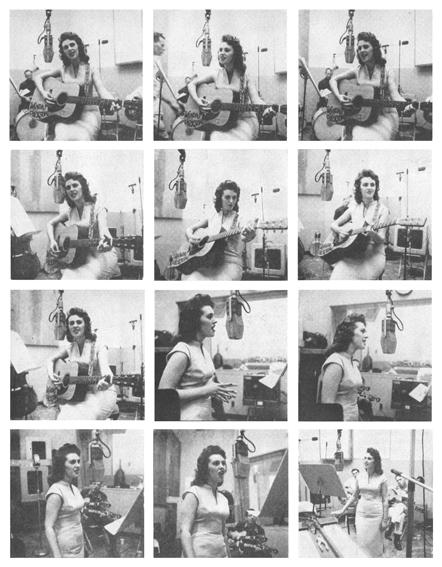 The two studio sessions
mentioned earlier were the only ones that Wanda cut for Capitol in 1956 and they clearly illustrate
her transition from hillbilly singer to rockabilly artist. The Decca years
had produced quality country sides, so producer Ken Nelson took few risks
at the June session ; three country songs were canned : 'Step By Step' (first
issued in France in 1977 on the second volume of the brilliant 'Rock And Roll At The Capitol Tower' series), 'Half As Good A Girl' (b-side to her first Capitol
single) and 'Cryin' Thru' The Night'. However, Thelma Blackmon's 'I Gotta
Know' was chosen as the top deck of her first purple label record (#3485). Blackmon (often called Blackman in error), another Oklahoma native, had already provided Wanda with 'It's The Same World' and 'I'd Rather Have A Broken Heart' while at Decca ; she would continue to give good songs to Wanda over the years, while recording herself four singles on MGM. The construction
of 'I Gotta Know' shifted constantly from a hillbilly melody to a fast-paced
rockabilly passage, bit like Arlie Duff's soon-to-be-released 'Alligator
Come Across' on Decca (#29987). Wanda delivered the goods effortlessly. Ably supported
by a stellar cast of country sidemen who had already tried their hand at the
new rockin' music - notably Joe Maphis whose sound
& style cannot be missed -, the result of that session was more than satisfactory. In 2012, Omnivore Recordings issued a Special Edition 10" six-track EP by Wanda entitled 'Capitol Rarities' (OVS 1041 - the same catalog number as Wanda's first original Capitol LP) which included the aforementioned 'Step By Step', a song that appears to have been co-written by Sonny James.
The two studio sessions
mentioned earlier were the only ones that Wanda cut for Capitol in 1956 and they clearly illustrate
her transition from hillbilly singer to rockabilly artist. The Decca years
had produced quality country sides, so producer Ken Nelson took few risks
at the June session ; three country songs were canned : 'Step By Step' (first
issued in France in 1977 on the second volume of the brilliant 'Rock And Roll At The Capitol Tower' series), 'Half As Good A Girl' (b-side to her first Capitol
single) and 'Cryin' Thru' The Night'. However, Thelma Blackmon's 'I Gotta
Know' was chosen as the top deck of her first purple label record (#3485). Blackmon (often called Blackman in error), another Oklahoma native, had already provided Wanda with 'It's The Same World' and 'I'd Rather Have A Broken Heart' while at Decca ; she would continue to give good songs to Wanda over the years, while recording herself four singles on MGM. The construction
of 'I Gotta Know' shifted constantly from a hillbilly melody to a fast-paced
rockabilly passage, bit like Arlie Duff's soon-to-be-released 'Alligator
Come Across' on Decca (#29987). Wanda delivered the goods effortlessly. Ably supported
by a stellar cast of country sidemen who had already tried their hand at the
new rockin' music - notably Joe Maphis whose sound
& style cannot be missed -, the result of that session was more than satisfactory. In 2012, Omnivore Recordings issued a Special Edition 10" six-track EP by Wanda entitled 'Capitol Rarities' (OVS 1041 - the same catalog number as Wanda's first original Capitol LP) which included the aforementioned 'Step By Step', a song that appears to have been co-written by Sonny James.
The
September session was even better. This time, there was no doubt that Wanda
had chosen to follow the rockabilly route. Only one country song was cut,
the super fine 'Silver Threads & Golden Needles' which later became a
minor standard (check out The Everly Bros' version on their WB album from1963,
'Sing Great Country Hits') ; the other three recordings were top-rate slices
of rockabilly : 'Baby Loves Him' (Jackson's own composition), the Gene Vincent-flavored 'Honey Bop', and 'Hot
Dog ! That Made Him Mad', a pop tune originally done by the Page Cavanaugh Trio on Hub, that she sings with devilish fun. Don't know if the late Joe Maphis had his carpet
slippers on that day but he did produce some wonderful soli - especially
the growling sound in 'Baby Loves Him' but also his soon-to-be trademark licks in 'Hot Dog !'. Joe apparently did not back up Wanda Jackson
again on record but he was a great asset on her early rockabilly
recordings. He would however play with her on numerous radio & TV shows such as 'Town Hall Party'. The lead guitar spot was subsequently filled by Buck Owens and then Vernon
Sandusky until Roy Clark came along with his lightnin' fingers.
.jpg)
.jpg)
'Hot Dog ! That Made Him Mad' b/w 'Silver Threads & Golden Needles' became Wanda's second Capitol record (#3575) but the bad review it received in the February '57 issue of 'C'n'W Jamboree' made it clear that the editorial staff hadn't forgiven her for switching to rockabilly.
'Baby Loves Him' and 'Honey Bop' also contain a dynamic steel guitar solo, courtesy of Ralph Mooney. That combination of rocking guitar and steel guitar would be part of the early Capitol Tower sound, a truly modern approach which will never sound dated. 'Baby Loves Him' was coupled with 'Cryin' Thru The Night' for her third Capitol single (#3637). It was reviewed in the April '57 issue of 'C'n'W Jamboree' where, as expected, it was given a somewhat lukewarm reception. 'Honey Bop' appeared much later as the flip of 'Just Queen For A Day' (#3941).
To be complete, I should add that the three rockers from the September session, in addition to 'I Gotta Know', were included on Wanda's second Capitol album, the unmissable 'Rockin' With Wanda', in 1960.
Wanda was voted 'Best New Female Singer' of 1956 in the Country'n'Western Jamboree nationwide poll. By then, she was already a fixture on Red Foley's Ozark Jubilee TV show and was touring constantly. The November '56 issue of 'Folk & Country Songs' reported that she had 'left July 4th for Alaska, where she did thirty days of personals and really wowed the folks down there.' They added that she was now on a 24-day tour of Missouri with promoter and hillbilly bandleader, T. B. Skarning. She would then grace the cover of their January '57 issue, where they called her 'The Singing Doll' !
As for her voice, it had matured a lot since the early Decca recordings. The childish tones had gone and it now showed much promise - which would eventually
materialize during those famous April 1958 sessions at the Capitol Tower when she cut a brace of rockers including the classic
'Let's Have A Party'. But this will be studied in length on another page devoted to the one & only Wanda Jackson !


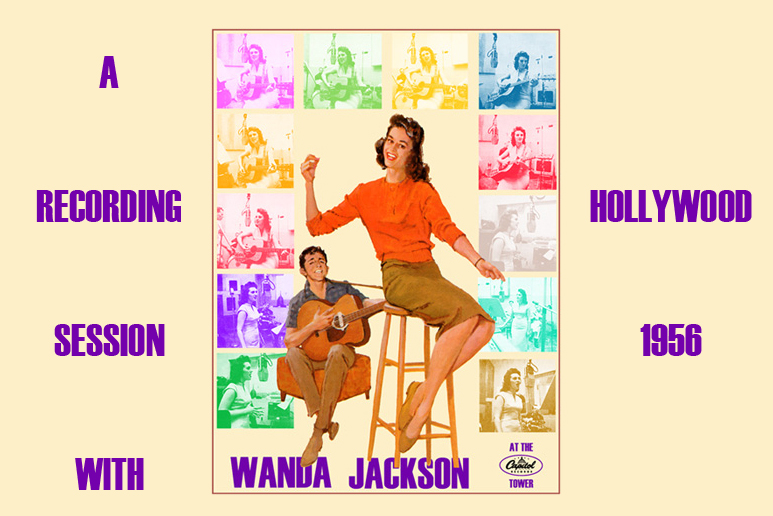

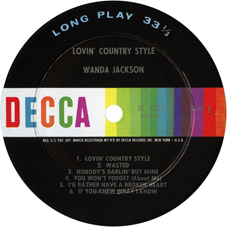

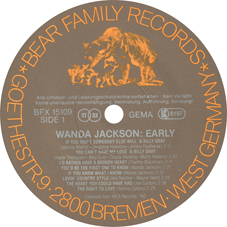


 Billy Gray, Decca #29800
Billy Gray, Decca #29800
